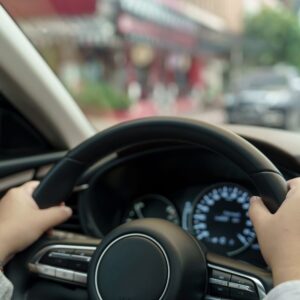Cruise control is a function most modern vehicles have. Best used on highways, it lets you drive at a constant, steady speed without keeping your foot on the acceleration pedal. This helps you relax and enjoy a long, smooth drive without too many manual inputs, as your vehicle takes full control of the throttle.
However, are there downsides to using this function? For example, does it save gas to use cruise control or does it have the opposite effect?
How Does Using Cruise Control Save Gas?
On average, using cruise control helps drivers save between 7-14% on gas because it helps vehicles maintain a steady, continuous speed. This is because there are no fluctuations in the engine’s power output unless you’re on hilly terrain or driving in moderately heavy traffic where adaptive cruise has to change the throttle angle a lot.
Constant acceleration and deceleration force the engine to work harder, making it use more gas. Cruise control’s steady speed removes these conditions completely.
Does Cruise Control Save On Gas All the Time?
No, cruise control doesn’t always help you save gas. If it did, it’d be more efficient to keep it on every time you drive outside of urban areas.
Many cruise control systems struggle on inconsistent roads, causing the engine to burn more gas than necessary. That’s why it’s best to disable this function when driving on rough, rocky terrain as well as hills and inclines with steep slopes and varied inclines.
When Should You Use Cruise Control?

Cruise control is best used when driving on highways and other long, even roads, especially those that are almost empty. It’s perfect for road trips because you can let your foot rest a bit so you can focus on the road.
On the other hand, never use cruise control when driving on slippery terrain or in harsh weather conditions that can impair your ability to drive. You’ll notice road conditions and know when to slow down. The cruise control doesn’t have the capacity to recognize wet or icy pavement ahead.
When the road is compromised, it’s better to have full control of your vehicle. Keeping your vehicle at the same speed without the ability to slow it down will make it more difficult to control. So disable cruise control when it’s raining, snowing, or when the road is slicked with ice.
It’s also not recommended to use cruise control when driving in town. There’s too much traffic and the roads often bend, wind, and intertwine. It’s better to have total control over your vehicle whenever you drive in urban areas to avoid hitting people and other vehicles.
Advantages of Cruise Control
Using cruise control can improve fuel efficiency, give drivers time to relax or focus, regulate speed, and reduce engine strain.
Boosts Fuel Efficiency
Because cruise control reduces the amount of fuel burned when you drive, the fuel economy increases. This means keeping a steady speed when driving on long stretches of road optimizes fuel consumption.
Helps Drivers Relax or Focus
Arguably, the biggest advantage of cruise control is the comfort it provides drivers. The ability to take your foot off the pedal and take in your surroundings goes a long way in helping you relax. This, in turn, lets you focus more on driving.
Regulates Speed
Cruise control helps drivers maintain a stable and steady speed. This reduces the risk of getting ticketed for speeding because it’s easier to stay below the speed limit.
Easier on the Engine
Cruise control doesn’t just use less fuel, it’s also easier on your vehicle. Accelerating and decelerating manually puts a lot of strain on the engine and the brakes. This doesn’t happen when cruise control is on, as it maintains a steady speed.
Disadvantages of Cruise Control
Like any other function, cruise control has drawbacks. Using it can make you complacent and lessen your road awareness. It also reduces your control over your vehicle, and it doesn’t work well on certain road conditions.
Reduces Road Awareness
It’s easy to get too comfortable using cruise control. If you don’t focus while you’re driving, your reaction time will decrease, increasing the risk of accidents. It’s easy to bump into obstacles and other vehicles if you don’t pay attention to your surroundings.
Less Control Over Vehicle
Another massive downside that comes with cruise control is how it becomes much harder to control your vehicle.
For example, in urban areas, you’ll need total control of your speed when making turns and avoiding obstacles. You won’t be able to adjust how well your vehicle accelerates or decelerates if cruise control is on.
Not Always Optimal
As mentioned, cruise control doesn’t do well in urban areas and less optimal road conditions. It should only be used on long empty roads with flat surfaces for maximum efficiency.
How to Get High-Quality Replacement Cruise Control Parts
Now that you know how much cruise control saves you on gas, you’ll likely want to keep the system in tip-top shape as much as possible. If your cruise control starts acting up, that’s potential savings down the drain! Thankfully, CarParts.com offers different cruise control components for your repair needs.
The extensive CarParts.com catalog might be a little intimidating at first. Fortunately, finding exactly what you need only takes a few clicks, thanks to our vehicle selector and search filters.
You can also reach out to our friendly customer service team for assistance. They can answer your questions about the different cruise control parts we have. They’ll even tell you all about our latest offers and customer-centric guarantees.
Keep your vehicle’s cruise control running optimally. Buy a cruise control module or other cruise control components at CarParts.com today.
Any information provided on this Website is for informational purposes only and is not intended to replace consultation with a professional mechanic. The accuracy and timeliness of the information may change from the time of publication.




















